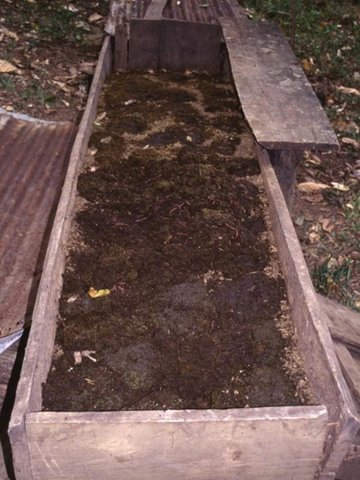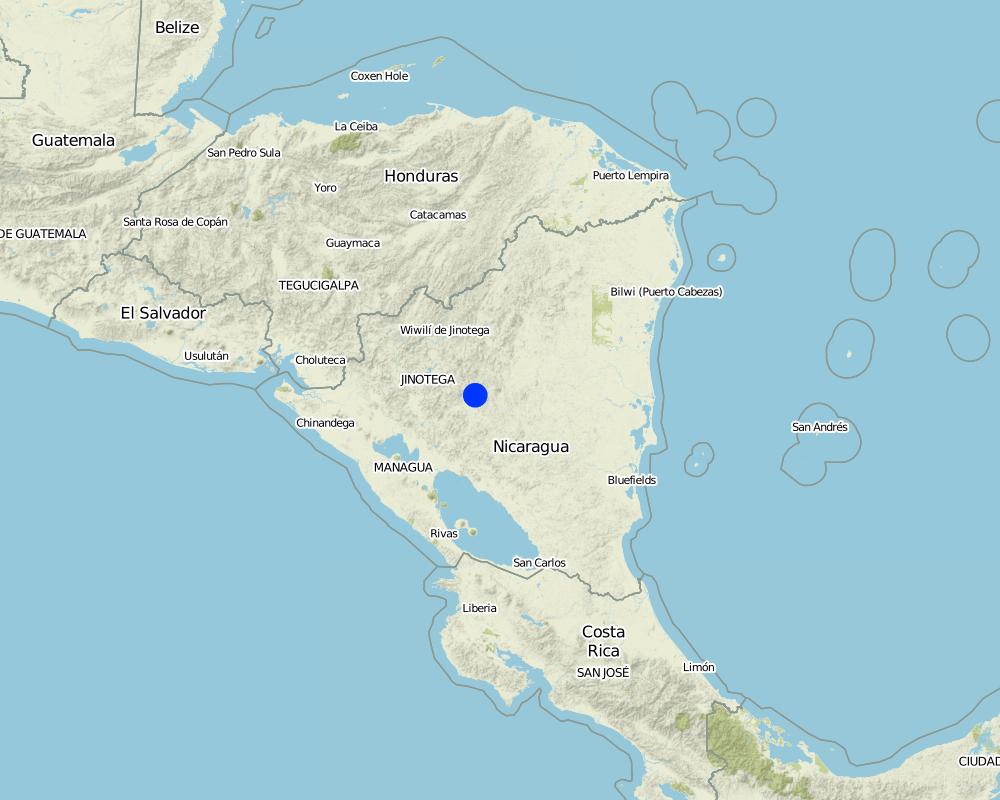Productive development and food security programme [尼加拉瓜]
- 创建:
- 更新:
- 编制者: Philippe Zahner
- 编辑者: –
- 审查者: David Streiff, Deborah Niggli
approaches_2349 - 尼加拉瓜
查看章节
全部展开 全部收起1. 一般信息
1.2 参与方法评估和文件编制的资源人员和机构的联系方式
SLM专业人员:
Gómez Julio
(505) 0772-7108
addacentral@addac.org
ADDAC Managua, Nicaragua
De ENITEL 3c al Norte y 75 varas al Este. Calle Santa Ana, Apartado Postal 161, Matagalpa, Nicaragua
有助于对方法进行记录/评估的项目名称(如相关)
Book project: where the land is greener - Case Studies and Analysis of Soil and Water Conservation Initiatives Worldwide (where the land is greener)有助于对方法进行记录/评估的机构名称(如相关)
Asociación para la Diversificación y el Desarrollo Agricultural Comunal (ADDAC) (Asociación para la Diversificación y el Desarrollo Agricultural Comunal (ADDAC)) - 尼加拉瓜1.3 关于使用通过WOCAT记录的数据的条件
编制者和关键资源人员接受有关使用通过WOCAT记录数据的条件。:
是
1.4 SLM技术问卷的参考

Vermiculture [尼加拉瓜]
Continuous breeding of earthworms in boxes for production of high quality organic compost.
- 编制者: Ramén Ernesto Caceres Ordonez
2. SLM方法的描述
2.1 该方法的简要说明
An integrated programme-based approach promoting participatory testing and extension of various SWC technologies, as well as providing institutional support.
2.2 该方法的详细说明
该方法的详细说明:
Aims / objectives: The Association for Agricultural Community Development and Diversification (ADDAC) is a non-profit NGO, founded in 1989, whose mission is to improve the living standard of poor rural families engaged in small/medium scale farming in marginal areas to the north of Nicaragua. The main purpose of ADDAC's approach is to develop and strengthen local capacity to analyse problems and find solutions for rural sustainable development. There are five main components: (1) food security and productive development, including technological improvement and diversification within traditional crop cultivation, and extension of alternative agricultural land use practices; (2) support to farmers??? organisations; (3) promotion of gender equality; (4) identification of alternatives in marketing; and (5) provision of an alternative credit system for farming. These fields of activities are based on the principles of organic agriculture and a powerful training process - using the methodology of 'popular education', which involves participatory training and extension activities.
Methods: ADDAC initiates its work in communities through PRA (Participatory Rural Appraisal) - evaluating problems and potential solutions. These serve as a base for the formulation of project proposals which are then submitted to interested financing organisations. Further steps include participatory planning, and later, evaluation, in collaboration with the land users. For execution of activities ADDAC contracts an interdisciplinary crew of specialists, which stays in the area. Twice a year a participatory reunion is organised to evaluate, and accordingly improve, the activities. Key to the approach is the formation of a grassroots organisation in each community to guarantee local management, build up alternative enterprises and promote community development. These organisations consist of representatives of local support groups, and farmers with a leading role in SWC application and extension. The organisations have various functions during the lifetime of a project: they are the counterparts of the extensionists for project execution, and later they ensure sustainability of activities. Farmers' associations are formed to improve storage and marketing of crops. Networks of local promoters exchange experience between communities and consolidate extension of alternative technologies. Demonstration farms serve as a tool for technology extension, innovation and validation.
2.5 采用该方法的国家/地区/地点
国家:
尼加拉瓜
区域/州/省:
Matagalpa
Map
×2.6 该方法的开始和终止日期
注明开始年份:
1989
2.7 方法的类型
- 基于项目/方案
2.8 该方法的主要目的/目标
Support the economical sustainability and food security of land users in the project area through increased production, diversification, soil conservation and environmental protection. - develop feasible production models, aimed at self-sufficiency and the integration of land users into an alternative internal and external market; build up alternative forms of marketing and credit systems. - community development and capacity building: build-up local farmers' organisation
The SLM Approach addressed the following problems: Lack of organisation and skills to analyse and overcome underlying problems of: - poverty; lack of financial resources for investments (eg in SWC). - insufficient food/poor nutrition. - soil degradation/indiscriminate burning of vegetation. - lack of appropriate technologies. - lack of access to public services and markets
2.9 推动或妨碍实施本办法所适用的技术的条件
社会/文化/宗教规范和价值观
- 阻碍
Resistance to implement SWC technologies by some land users
Treatment through the SLM Approach: Awareness raising, demonstration plots, convince with facts.
财务资源和服务的可用性/可得性
- 阻碍
Poverty, lack of resources for investments into SWC.
Treatment through the SLM Approach: Support in the form of credit, basically in kind but also in cash (see credit section).
机构设置
- 阻碍
Lack of collaboration between land users.
Treatment through the SLM Approach: Strengthen farmers' organisation.
法律框架(土地使用权、土地和水使用权)
- 启动
Most of the land users have individual properties which facilitates the implementation of the SWC approach activities.
- 阻碍
Lack of land use rights.
Treatment through the SLM Approach: Problem cannot be resolved under the project.
3. 相关利益相关者的参与和角色
3.1 该方法涉及的利益相关者及其职责
- 当地土地使用者/当地社区
The integration of women is a key element of the approach. Nevertheless, there are moderate differences due to cultural factors: men are mainly in charge of agricultural activities, whereas women work in the household.
- SLM专家/农业顾问
- 国家政府(规划者、决策者)
3.2 当地土地使用者/当地社区参与该方法的不同阶段
| 当地土地使用者/当地社区的参与 | 指定参与人员并描述活动 | |
|---|---|---|
| 启动/动机 | 互动 | rapid/participatory rural appraisal; participatory planning in public meetings |
| 计划 | 互动 | public meetings, workshops/seminars; assemblies for municipal planning (elaboration of community action plan) |
| 实施 | 互动 | responsibility for major steps; execution of the action plans where each community decides |
| 监测/评估 | 互动 | Mainly: public meetings; partly: workshop/seminars, measurements/observations; a specialist is in charge of the continuation of activities and of the planning process with each community; annual assembly of delegates representing all communities assisted by ADDAC |
| Research | 互动 | on-farm; on-farm experimentation with interested land users: assessment of different technologies (variety tests, evaluation of ecological effects, etc) |
3.4 有关SLM技术选择的决策
具体说明谁有权决定选择要实施的技术:
- 主要是土地使用者,由SLM专家提供支持
解释:
Decisions on the method of implementing the SLM Technology were made by mainly by land users supported by SLM specialists
4. 技术支持、能力建设和知识管理
4.1 能力建设/培训
是否为土地使用者/其他利益相关者提供培训?:
是
培训形式:
- 农民对农民
- 示范区域
- 公开会议
涵盖的主题:
The form of training promoted by ADDAC is called 'popular education'. It is a continuous and participatory process of mutual learning between farmers and technicians, based on a course of 'action - reassessment - action', with the aim of re-establishing indigenous knowledge, improving local self-esteem and the ability to analyse innovations, and, in the long term, to build up the capacity withi
4.2 咨询服务
土地使用者有权使用咨询服务吗?:
是
指明是否提供了咨询服务:
- 在土地使用者的土地上
说明/注释:
Key elements: demonstration areas, technical assistance through farm visits, farmer-to-farmer extension, local promoters organised into 'Local Support Groups', associated network.
4.3 机构强化(组织发展)
是否通过这种方法建立或加强了机构?:
- 是,少许
具体说明机构的强化或建立程度:
- 本地
- building up groups (see Annexe 3)
4.4 监测和评估
监测和评估是该方法的一部分吗?:
是
注释:
Socio-cultural aspects were ad hoc monitored by 0 through observations; indicators: land users needs
Economic / production aspects were ad hoc monitored by 0 through observations; indicators: nutritional security, cost-benefit-ratio, deversification, organic products, certified production, production for markets
No. of land users involved aspects were regular monitored by 0 through measurements; indicators: strategic plan, progress of project
Management of Approach aspects were regular monitored by None through measurements; indicators: None
Training aspects were regular monitored by None through observations; indicators: land users trained as local promoters
There were several changes in the Approach as a result of monitoring and evaluation: at the beginning the approach consisted only of two components: training and research. Then it was broadened to involve extension of SWC technologies and promotion of crop diversification. Later the credit programme and the organisational component became part of the approach. The approach activities are supposed to be a continuously expanded based on the needs of the land users.
4.5 研究
研究是该方法的一部分吗?
是
明确话题:
- 技术
提供进一步的细节,并指出是谁做的研究:
Research is carried out on demonstration farms through local promoters. Topics include on-farm testing of technologies, and adaptive trials with maize and pea varieties.
5. 融资和外部物质支持
5.1 该方法中SLM组成部分的年度预算
注释(例如主要的资助来源/主要捐助者):
Approach costs were met by the following donors: international non-government (-): 90.0%; national non-government (-): 10.0%
5.2 为土地使用者提供财政/物质支援
土地使用者是否获得实施该技术的财政/物质支持?:
否
5.3 对特定投入的补贴(包括劳动力)
- 设备
| 具体说明哪些投入得到了补贴 | 程度如何 | 对补贴做出具体说明 |
|---|---|---|
| 工具 | 部分融资 | |
- 农业
| 具体说明哪些投入得到了补贴 | 程度如何 | 对补贴做出具体说明 |
|---|---|---|
| fresh cattle manure | Gift from neigbours to farmers who don't have cattle | |
- 基建
| 具体说明哪些投入得到了补贴 | 程度如何 | 对补贴做出具体说明 |
|---|---|---|
| community infrastructure | 充分融资 | |
如果土地使用者的劳动力是一项重要的投入,那么是不是:
- 自愿
注释:
land users works on their own farms at their own cost.
5.4 信用
是否根据SLM活动的方法给予信用值?:
是
对条件(利率、回报等)进行具体说明:
Interest rate charged: 1.5%; repayment conditions: Credit was provided through the programme of alternative financing by ADDAC. The 1.5% interest rate (lower than the market rate) is accessible to individuals and organised groups..
Interest was lower than market rate.
6. 影响分析和结论性陈述
6.1 方法的影响
该方法是否帮助土地使用者实施和维护SLM技术?:
- 否
- 是,很少
- 是,中等
- 是,支持力度很大
Did other land users / projects adopt the Approach?
- 否
- 是,很少
- 是,中等
- 是,支持力度很大
There are 6 more projects assisted by ADDAC, which use the same approach in the north of Nicaragua.
6.3 方法活动的可持续性
土地使用者能否维持通过该方法实施的措施(无外部支持的情况下)?:
- 是
6.4 该方法的长处/优点
| 编制者或其他关键资源人员认为的长处/优势/机会 |
|---|
| Growing active integration of women (25% more contribution to farm income and >25% more participation in decision making in comparison with non-participants) (How to sustain/ enhance this strength: Keep the gender programme as a component of the approach.) |
| Farmers' organisations: build up capacity for autonomous management of alternative development activities (How to sustain/ enhance this strength: Integrate more farmers in the baseline organisations.) |
| Efficient extension method: 86% of involved land users apply more than 3 different SWC technologies promoted by the approach which contributes to sustainable development of the region (How to sustain/ enhance this strength: Maintain and extend present farmer-to-farmer extension system: continue training of local promoters, network of promoters, local support group.) |
| Evaluation of land users' needs and involvement of new approach components according to their needs; continuous mutual learning process between land users and between land users and extensionists/specialists (How to sustain/ enhance this strength: Continue the present 6-monthly evaluation procedures; implement a system of information, communication, evaluation and monitoring to analyse the impact of the approach activities.) |
| Increasing self-esteem of the people. |
6.5 该方法的弱点/缺点以及克服它们的方法
| 编制者或其他关键资源人员认为的弱点/缺点/风险 | 如何克服它们? |
|---|---|
| Process takes long and requires high inputs of human resources and materials | In an integrated approach with strong participation of land users this problem is unavoidable; formulation of good project proposals help in finding donors to finance long-term programmes. |
7. 参考和链接
7.1 方法/信息来源
- 实地考察、实地调查
- 与土地使用者的访谈
7.2 参考可用出版物
标题、作者、年份、ISBN:
Rolando Bunch (1990) Dos Mazorcas de Ma??z Anon (1990) El peque?? agricultor en Honduras ADDAC (2002) Plan
链接和模块
全部展开 全部收起链接

Vermiculture [尼加拉瓜]
Continuous breeding of earthworms in boxes for production of high quality organic compost.
- 编制者: Ramén Ernesto Caceres Ordonez
模块
无模块


